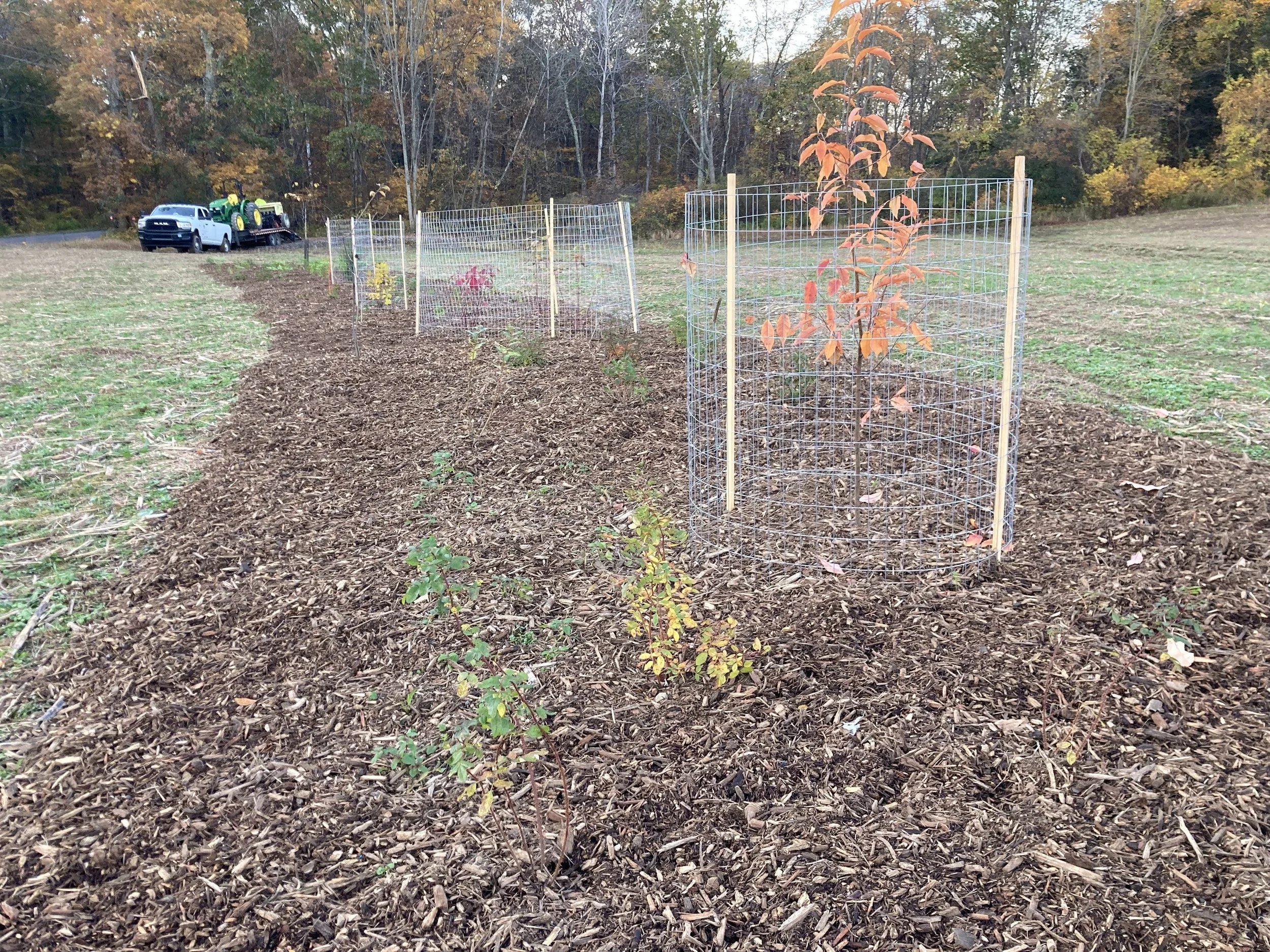INSTALL YOUR PROJECT
Deer-Proofing
In most of the Hudson Valley, deer protection is non-negotiable if plants are to thrive and support their at-risk pollinator partners. Repeated deer browse will destroy plants and can even contribute more directly to pollinator decline as insects are munched along with plant material!
While many gardeners search for deer resistant plant species, deer preferences vary widely and most native plants have the potential to be browsed under the right conditions. The plants recommended in this guide are generally not “deer resistant” by any definition - in fact, many are now uncommon on our landscapes precisely because they are so beloved by deer.
| Method | Pros | Cons | Best For | Lifespan |
|---|---|---|---|---|
| Tree tubes | Available off-the-shelf, easy to apply, easy to mow and weed around | Made of plastic; may lead to weakened plant stems; doesn’t work for shrubs or perennials; may encourage rodents | Single-stemmed trees in low-maintenance areas | Temporary - 3-5 years |
| Wire cages | Works for both trees and shrubs; recyclable material | No prefab option; hard to weed or maintain inside cage and around edges | Shrubs and trees in medium-high maintenance areas | Temporary - 3-5 years |
| Repellent sprays | Easy to apply; biodegradable | Must be re-applied and updated regularly; deer can become acclimated | Small plantings in high maintenance areas (close to human habitation) | Short-term - a few months |
| Perimeter fence (wire, plastic, or electrified) | Efficient option to protect a large area of mixed planting: trees, shrubs, perennials | Expensive; edge must be mowed or weeded | Larger plantings in low-maintenance areas; meadows | Temporary or permanent |
Deer Protection: Individual Plants and Gardens
To protect individual trees, tubes and cages are often used as a temporary measure to allow plants to grow “out of browse height”, that is, to allow the growing plant to get taller than deer can comfortably reach while grazing, approximately 5’. For shrubs and small plants, many species may never grow past 5’, leaving them susceptible to deer browse throughout their life. In this case, it’s best to consider other options - cages are not a good permanent solution due to the difficulty of weeding in and around them.
This young bee balm plant (Monarda didyma) was browsed within a week of being planted in Red Hook, NY. Photo: PCA
TUBES are appropriate for single-stemmed trees. They are made of a plastic that allows light to infiltrate and trees to grow, and are usually applied at time of planting. Typical cost is $5-$15 per tube. The DEC’s Trees for Tribs program supplies tubes along with trees for riparian areas.
CAGES are wider than tubes and are appropriate for multi-trunked trees or suckering shrubs. Usually prefab options are not available - you can make cages from a roll of wire fence (available at any hardware or big-box home store) by cutting sections long enough to make 12-18” diameter rounds and securing the cut edges with wire or zip ties. 4’ fence rolls are more widely available, but 5’ height provides better protection.
Tree tubes installed in Gardiner, NY as part of a Trees for Tribs riparian planting. Photo: Adam T. Deen
SPRAYS to discourage deer have generally short-lived effectiveness - deer often get used to them after a while and begin to browse sprayed plants that were unappetizing at first. Periodically changing the formulation of spray used can help with this. Sprays may not be practical for large areas of planting, and must be replenished consistently, including after rain; but they can be the best option for single specimen shrubs or trees in backyard settings where tubes and cages aren’t appealing.
Deer Protection: Fencing Larger Areas and Meadows
Around meadows, large-scale plantings, or plantings that include many shrubs and perennials for which individual cages or tubes aren’t a practical solution, consider a perimeter deer fence. Fencing adds cost but is often well worth it to ensure that all the money, time, and effort spent on your native pollinator planting doesn’t simply vanish into the mouths of hungry deer.
In yards and gardens, netted deer fencing is inexpensive, nearly invisible, and easy to install. For larger or more rural areas we recommend solar-charged electric strand fencing as the most cost-effective, aesthetically pleasing, low-maintenance and functional fencing method. When touched, electric fences produce a shock that is painful but not harmful to deer, humans, and other animals. Note that it’s still important to supervise children and pets in the vicinity of any electric fencing!
Installing single-strand solar electric fencing around a new riparian buffer planting. Photo: Adam T. Deen
Wire cages around newly installed plants. Photo: PCA
In unfenced meadows, deer will produce a “sorting-out” effect over time: the most deer-attractive species will disappear, and the overall species diversity will decrease. Even plants that can withstand repeated browse will be unable to reach their full size, and may not bloom consistently.
Protecting your pollinator plants from deer browse is a critical part of supporting pollinators.




